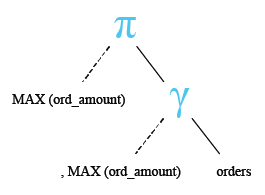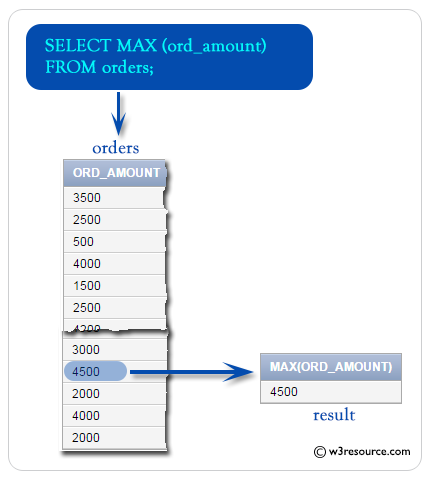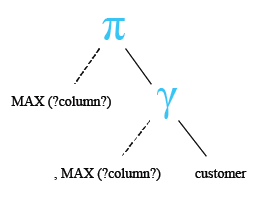SQL MAX() function
MAX() function
The aggregate function SQL MAX() is used to find the maximum value or highest value of a certain column or expression. This function is useful to determine the largest of all selected values of a column.
Syntax:
MAX ([ALL | DISTINCT] expression )
DB2 and Oracle Syntax:
MAX ([ALL | DISTINCT] expression ) OVER (window_clause)
Parameters:
| Name | Description |
|---|---|
| ALL | Applies to all values. |
| DISTINCT | Consider each unique value. DISTINCT is not meaningful with MAX function. |
| expression | Expression made up of a single constant, variable, scalar function, or column name or any combination of arithmetic, bitwise, and string operators. MAX can be used with numeric, character, and datetime columns, but not with bit columns. Aggregate functions and subqueries are not permitted. |
DBMS Support: COUNT() function
| DBMS | Command |
| MySQL | Supported |
| PostgreSQL | Supported |
| SQL Server | Supported |
| Oracle | Supported |
Syntax diagram - MAX() function

Example:
To get maximum 'ord_amout' from the 'orders' table, the following SQL statement can be used :
Sample table: orders
SELECT MAX (ord_amount)
FROM orders;
Relational Algebra Expression:

Relational Algebra Tree:

Output:
MAX(ORD_AMOUNT)
---------------
4500
Pictorial Presentation:

SQL MAX() with addition of two columns
To get the maximum value of (opening_amt+receive_amt) from the customer table, the following SQL statement can be used :
Sample table: customer
SELECT MAX (opening_amt+receive_amt)
FROM customer;
Relational Algebra Expression:

Relational Algebra Tree:

Output:
MAX(OPENING_AMT+RECEIVE_AMT)
----------------------------
19000
Note: Outputs of the said SQL statement shown here is taken by using Oracle Database 10g Express Edition
Here is a slide presentation of all aggregate functions.
Practice SQL Exercises
- SQL Exercises, Practice, Solution
- SQL Retrieve data from tables [33 Exercises]
- SQL Boolean and Relational operators [12 Exercises]
- SQL Wildcard and Special operators [22 Exercises]
- SQL Aggregate Functions [25 Exercises]
- SQL Formatting query output [10 Exercises]
- SQL Quering on Multiple Tables [8 Exercises]
- FILTERING and SORTING on HR Database [38 Exercises]
- SQL JOINS
- SQL SUBQUERIES
- SQL Union[9 Exercises]
- SQL View[16 Exercises]
- SQL User Account Management [16 Exercise]
- Movie Database
- BASIC queries on movie Database [10 Exercises]
- SUBQUERIES on movie Database [16 Exercises]
- JOINS on movie Database [24 Exercises]
- Soccer Database
- Introduction
- BASIC queries on soccer Database [29 Exercises]
- SUBQUERIES on soccer Database [33 Exercises]
- Hospital Database
- Employee Database
- More to come!
Want to improve the above article? Contribute your Notes/Comments/Examples through Disqus.
Previous: Avg with round, group by
Next: Max with Group by, Order by
SQL: Tips of the Day
SQL Server SELECT into existing table.
INSERT INTO dbo.TABLETWO SELECT col1, col2 FROM dbo.TABLEONE WHERE col3 LIKE @search_key
This assumes there's only two columns in dbo.TABLETWO - you need to specify the columns otherwise:
INSERT INTO dbo.TABLETWO (col1, col2) SELECT col1, col2 FROM dbo.TABLEONE WHERE col3 LIKE @search_key
Database: SQL Server
Ref: https://bit.ly/3y6tpA3
- New Content published on w3resource:
- HTML-CSS Practical: Exercises, Practice, Solution
- Java Regular Expression: Exercises, Practice, Solution
- Scala Programming Exercises, Practice, Solution
- Python Itertools exercises
- Python Numpy exercises
- Python GeoPy Package exercises
- Python Pandas exercises
- Python nltk exercises
- Python BeautifulSoup exercises
- Form Template
- Composer - PHP Package Manager
- PHPUnit - PHP Testing
- Laravel - PHP Framework
- Angular - JavaScript Framework
- Vue - JavaScript Framework
- Jest - JavaScript Testing Framework
